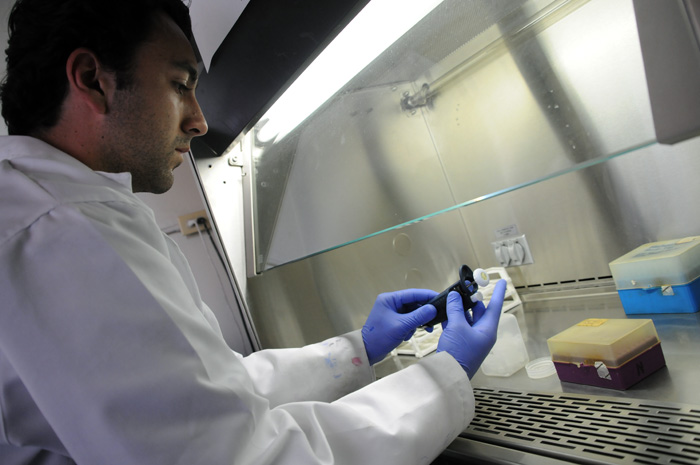The first part of the investigation was focused on understanding the metabolic processes used by Leishmania, a protozoan parasite responsible for the transmission of leishmaniasis, to obtain the energy that enables it to adapt to any environment. This pathogen agent that attacks mammals causes thousands of cases of this infectious disease in Colombia every year. This disease is transmitted to humans by the bite of an insect (vector) of the genus Lutzomyia or Phlebotomus.
According to the World Health Organization, leishmaniasis, which shows three predominant common forms (cutaneous, mucocutaneous and visceral), is distributed in America, Europe, Africa and Asia, and considered endemic in tropical and subtropical regions in 88 countries. Its prevalence in the world is calculated in 20 million cases and its annual incidence fluctuates between 1,5 and 2 million new affected patients.
"In Colombia, there are three common forms of this disease, being cutaneous the most frequent. Visceral leishmaniasis is endemic and it is commonly found in the valley of Magdalena River and its tributaries. Vector L. longipalpis is also present in some other regions such as Tolima, Huila and Cundinamarca, and vector L. evansi in Bolívar, Córdoba and Sucre," asserted Martha Stella Ayala Sotelo, coordinator of the Parasitology Group of the National Institute of Health (INS, for its acronym in English).
Based on the 2009 annual report on the behavior of the leishmaniasis in Colombia, made by the Deputy Direction of Surveillance and Control on Public Health of INS, up to last year, 12,232 cases were reported, from which 98,7% were cutaneous; 0,8%, mucocutaneous; and 0,5%, visceral. The most affected departments are Meta and Guaviare, reporting accumulated incidences over 708 cases in each 100 thousand inhabitants, followed by Caquetá, Santander, Nariño and Putumayo.
Given the epidemic power of leishmaniasis, the seriousness of the lesions that it produces and the unavailability of vaccines or effective treatments against it, Luis Ernesto Contreras, a student of the Science-Biochemistry Master program of Universidad Nacional de Colombia, studied the parasite. From the study An approximation to the metabolism of the Nicotinamide Adenine dinucleotide (NAD+) in Leish-mania, he obtained results that could be the starting point for the development of therapeutic strategies to fight against the disease.
The advancements are considered to be so promissory that, in 2010, Contreras obtained the first place in the Natural Sciences area of the National Contest of Best Thesis Work Otto de Greiff, which evaluates the most outstanding thesis in ten universities of Colombia.
The investigation
"We decided to study the existence of the molecular components in charge of synthesizing the coenzyme NAD+ in the parasite, and it was very interesting because in the process we discovered therapeutic targets that could be eventually used to fight the pathogen," affirmed the young researcher.
The NAD+ is part of multiple events in the cell metabolism and energy production due to its properties of electronic transference. Such events prove its functional versatility in the entire organism, from bacteria to humans.
"We could say that it is like an energetic coin in the cells and its synthesis is very complex. We were looking for its most important point and we found it in the parasite. Through bioinformatic strategies and molecular biology tools, we identified the NMNAT (Nicotinamide Mononucleotide Adenylyltransferase) in the genome of the organism. Subsequently, we reproduced it in the lab using recombining DNA, which was introduced in the Escherichia coli, a system that allowed us to obtain big amounts of the protein," asserted professor María Helena Ramírez, director of the research group in Biochemistry of the Chemistry Department at Universidad Nacional de Colombia
"Taking into account the progressive increase of the Leishmania"s resistance to the current control measures, it is necessary to develop new therapeutic strategies, deeply knowing its biology. The results allowed identifying molecular markers, which are exclusive of the parasite and are essential to performe diagnostic tests," added the researcher.
Knowing your enemy
This study is the first experimental approach to the NAD+ metabolism in such organism, which creates new opportunities for the development of control strategies from a biochemist and molecular perspective of the biology of the Leishmania.
Professor Ramírez explains that "knowing the metabolism of the protozoan is a reference point to compare it to that of the humans. We need to determine which the differences are between the molecule of the parasite and ours. If we could detect it, we would be able to define attack strategies."
"We managed to identify the structural differences between the proteins of humans and those of the parasite. This result could be used to directly attack the Leishmania protein without affecting the carrier," said Contreras.
The second part of the project is being developed and it consists on characterizing the enzymes of the protein. "We need to see in detail the way it works. For doing this, we need to study the speeds in which it works and the way in which it adapts to temperature, pH and concentration changes, for instance," asserted Professor Ramírez.
This scientific work is a starting point to develop new research on Leishmania and the metabolism of NAD+, a valuable aspect for a tropical country such as Colombia, in which many cases of diseases are reported due to these parasites.
 Correo Electrónico
Correo Electrónico
 DNINFOA - SIA
DNINFOA - SIA
 Bibliotecas
Bibliotecas
 Convocatorias
Convocatorias
 Identidad UNAL
Identidad UNAL



